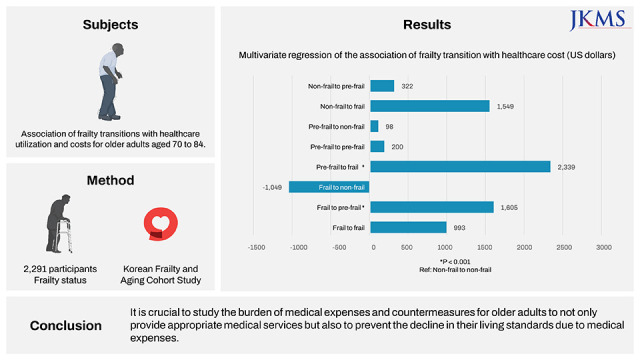3. Statistics Korea. Statistics on the Aged. 2021. Daejeon, Korea: Statistics Korea;2021.
4. Park S, Nam JY. Association between Changes in multiple chronic conditions and health expenditures among elderly in South Korea: Korean longitudinal study of aging 2014–2018. Health Policy Manag. 2022; 32(3):282–292.
5. National Health Insurance Service. Health Insurance Statistical Yearbook 2020. Wonju, Korea: National Health Insurance Service;2021.
6. Fried LP, Tangen CM, Walston J, Newman AB, Hirsch C, Gottdiener J, et al. Frailty in older adults: evidence for a phenotype. J Gerontol A Biol Sci Med Sci. 2001; 56(3):M146–M156. PMID:
11253156.
7. Cesari M, Prince M, Thiyagarajan JA, De Carvalho IA, Bernabei R, Chan P, et al. Frailty: an emerging public health priority. J Am Med Dir Assoc. 2016; 17(3):188–192. PMID:
26805753.
8. Lang PO, Michel JP, Zekry D. Frailty syndrome: a transitional state in a dynamic process. Gerontology. 2009; 55(5):539–549. PMID:
19346741.
9. Ahmed N, Mandel R, Fain MJ. Frailty: an emerging geriatric syndrome. Am J Med. 2007; 120(9):748–753. PMID:
17765039.
10. Eamer GJ, Clement F, Holroyd-Leduc J, Wagg A, Padwal R, Khadaroo RG. Frailty predicts increased costs in emergent general surgery patients: a prospective cohort cost analysis. Surgery. 2019; 166(1):82–87. PMID:
31036332.
11. Robinson TN, Wu DS, Stiegmann GV, Moss M. Frailty predicts increased hospital and six-month healthcare cost following colorectal surgery in older adults. Am J Surg. 2011; 202(5):511–514. PMID:
21890098.
12. Kim MJ, Jang SY, Cheong HK, Oh IH. Association of frailty with healthcare costs using claims data in Korean older adults aged 66. J Nutr Health Aging. 2021; 25(5):653–659. PMID:
33949633.
13. Bock JO, König HH, Brenner H, Haefeli WE, Quinzler R, Matschinger H, et al. Associations of frailty with health care costs--results of the ESTHER cohort study. BMC Health Serv Res. 2016; 16(1):128. PMID:
27074800.
14. Jin HY, Liu X, Xue QL, Chen S, Wu C. The association between frailty and healthcare expenditure among Chinese older adults. J Am Med Dir Assoc. 2020; 21(6):780–785. PMID:
32331768.
15. Hajek A, Bock JO, Saum KU, Matschinger H, Brenner H, Holleczek B, et al. Frailty and healthcare costs-longitudinal results of a prospective cohort study. Age Ageing. 2018; 47(2):233–241. PMID:
29036424.
16. Ensrud KE, Kats AM, Schousboe JT, Taylor BC, Cawthon PM, Hillier TA, et al. Frailty phenotype and healthcare costs and utilization in older women. J Am Geriatr Soc. 2018; 66(7):1276–1283. PMID:
29684237.
17. Li CM, Lin CH, Li CI, Liu CS, Lin WY, Li TC, et al. Frailty status changes are associated with healthcare utilization and subsequent mortality in the elderly population. BMC Public Health. 2021; 21(1):645. PMID:
33794860.
18. Fan L, Tian Y, Wang J, Ding Y, Wang S, Xue H, et al. Frailty predicts increased health care utilization among community-dwelling older adults: a longitudinal study in China. J Am Med Dir Assoc. 2021; 22(9):1819–1824. PMID:
33662331.
19. Son JH, Kim SY, Won CW, Choi HR, Kim BS, Park MS. Physical frailty predicts medical expenses in community-dwelling, elderly patients: three-year prospective findings from living profiles of older people surveys in Korea. Eur Geriatr Med. 2015; 6(5):412–416.
20. García-Nogueras I, Aranda-Reneo I, Peña-Longobardo LM, Oliva-Moreno J, Abizanda P. Use of health resources and healthcare costs associated with frailty: the FRADEA Study. J Nutr Health Aging. 2017; 21(2):207–214. PMID:
28112778.
21. Han L, Clegg A, Doran T, Fraser L. The impact of frailty on healthcare resource use: a longitudinal analysis using the Clinical Practice Research Datalink in England. Age Ageing. 2019; 48(5):665–671. PMID:
31297511.
22. Won CW, Lee S, Kim J, Chon D, Kim S, Kim CO, et al. Korean frailty and aging cohort study (KFACS): cohort profile. BMJ Open. 2020; 10(4):e035573.
23. Cheol Seong S, Kim YY, Khang YH, Heon Park J, Kang HJ, Lee H, et al. Data resource profile: the National Health Information Database of the National Health Insurance Service in South Korea. Int J Epidemiol. 2017; 46(3):799–800. PMID:
27794523.
24. Gobbens RJ, van Assen MA, Luijkx KG, Wijnen-Sponselee MT, Schols JM. Determinants of frailty. J Am Med Dir Assoc. 2010; 11(5):356–364. PMID:
20511103.
25. Hubbard RE. Sex differences in frailty. Interdiscip Top Gerontol Geriatr. 2015; 41:41–53. PMID:
26301978.
26. Palmer KT, D’Angelo S, Harris EC, Linaker C, Gale CR, Evandrou M, et al. Frailty, prefrailty and employment outcomes in Health and Employment After Fifty (HEAF) Study. Occup Environ Med. 2017; 74(7):476–482. PMID:
28062832.
27. Ottenbacher KJ, Graham JE, Al Snih S, Raji M, Samper-Ternent R, Ostir GV, et al. Mexican Americans and frailty: findings from the Hispanic established populations epidemiologic studies of the elderly. Am J Public Health. 2009; 99(4):673–679. PMID:
19197079.
28. Gobbens RJ, van Assen MA, Luijkx KG, Schols JM. The predictive validity of the Tilburg Frailty Indicator: disability, health care utilization, and quality of life in a population at risk. Gerontologist. 2012; 52(5):619–631. PMID:
22217462.
29. Fabrício-Wehbe SC, Rodrigues RA, Haas VJ, Fhon JR, Diniz MA. Association of frailty in hospitalized and institutionalized elderly in the community-dwelling. Rev Bras Enferm. 2016; 69(4):691–696. PMID:
27508474.
30. Ilinca S, Calciolari S. The patterns of health care utilization by elderly Europeans: frailty and its implications for health systems. Health Serv Res. 2015; 50(1):305–320. PMID:
25139146.
31. Li CY, Al Snih S, Chou LN, Karmarkar A, Kuo YF, Markides KS, et al. Frailty transitions predict healthcare use and Medicare payments in older Mexican Americans: a longitudinal cohort study. BMC Geriatr. 2020; 20(1):189. PMID:
32487037.
32. Park JH. How to Use Big Data From NHIS Bigdata. The 5th Clinical Research Methodology Workshop. Seoul, Korea: Korean Association for the Study of the Liver;2016.
33. Jeong HS, Shin JW, Moon SW, Choi JS, Kim H. 2018 current health expenditures and national health accounts in Korea. Health Policy Manag. 2019; 29(2):206–219.
34. Kim NS, Jun J, Song E, Cha MR, Kim CO, Kim KJ. Development of Strategy on Senior Friendly Healthcare for Healthy Ageing. Sejong, Korea: Korea Institute for Health and Social Affairs;2018.







 PDF
PDF Citation
Citation Print
Print





 XML Download
XML Download